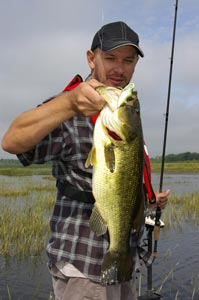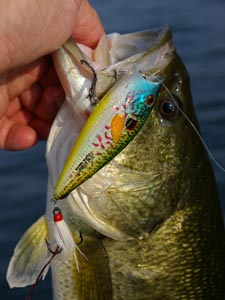
Bass fishing is like a religion. To the ardent angler, it is a passion fueled by an insatiable appetite for all things Micropterus. Biblical? Not really, although, if truth be known, we are all guilty of praying to the fishing gods from time to time.
 |
| The author with a bass caught topwatering. |
In terms of techniques, the art of topwatering is as thrilling as they get for the bassin' disciples. Visually, it elicits a water-churning excitement that often leaves the pulse in a frenzied state.
But as with any technique, there are countless ways to improve upon the end result, mainly through refinements and the changing of old ways. The following list of commandments offer an excellent starting point for this season — and hopefully provides the guidance to bring you more and bigger bass.
1. You Shall Work the Surface All Day Long
Ask any bass nut when their favorite time to topwater is, and your typical response will be dawn and dusk. Hardly surprising, as both have been engrained in our psyche since the time we first picked up a rod and reel. Yes, both of these low-light periods produce stellar results, but the time in between is also worthy of your topwater attention.
Bass are opportunistic feeders, and certain conditions will see them willing to look upwards for a bite, even during the lull of a midday period. An approaching front is one such occasion, as are those times when the wind and waves are tumbling into emergent structure. Murky water is another.
Hot weather periods and slop are also conducive to surface bites. And with the advent of weedless toads and frogs on the market, working bass-holding structure such as this can be a daylong pursuit worthy of coughing up great rewards. Bottom line is — bass will bite on top all day long. Think outside the box, keep an eye on conditions, and work lures that are effective. The "dawn and dusk" bite can definitely be lengthened.
A tournament friend of mine routinely tosses a Zara Spook throughout the day when fishing for money. He's cashed many checks. The way he looks at it is, most guys aren't doing it, and bass will always hit surface baits if you work them long enough through productive areas. Can't argue with that logic.
2. You Shall Break the Confidence Curse
We all have our favorite topwater baits, and sadly, we are guilty of overusing them throughout the season. And if you are consistently tossing the same bait day after day, regardless of conditions, then breaking the curse is in your best interest.
Early in my bassin' career, a Zara Spook Junior was the one topwater I would regularly reach for. In fact, I had a half dozen in my box of the same hue. They certainly caught bass, but unfortunately I became programmed to toss only that lure, regardless of the situation. It became my confidence bait, and remained that, even on those days when the fish refused to bite. It took me a few seasons to realize that having confidence in a lure can be good — but too much confidence (and an unwillingness to change) can put you at a serious disadvantage.
Make sure you have an ample supply of different styles of topwater baits — including buzzbaits, poppers, chuggers, cigar-style, wake baits, toads and frogs. And with these baits, be proactive in switching things up. Variety is the key to getting more bites on top and ultimately overcoming the confidence curse.
3. You Shall Experiment With Speed and Cadence
Many people make the mistake of working a topwater lure at a predetermined speed and cadence. Does this ring a bell: cast popper out, let surface rings disperse, pop-pop, pause, pop-pop, pause, pop-pop, pause, repeat. This will certainly work most of the time, but to really get the fish wound up and willing to strike, you need to change things up every once in a while.
Speed up your lure during mid-retrieve, rip it across the surface at splash down, or simply dead stick it in place halfway back to the boat. Change is good, and it will be these nuances and variables that can turn a following fish into a netted one.
4. You Shall Replace All Inferior Hooks
Topwater baits can still be found on tackle shelves with inferior or sub-standard hooks. When dealing with quick-striking and lunging fish, sticky-sharp hooks are mandatory on all of your baits.
 |
| Topwatering for bass isn't just for shallow water bass can be caught on the surface when working deep waters. |
Change treble hooks if they are lacking in quality, with a nod going to any of the chemically sharpened replacements hooks currently on the market. Some that have served me well are the Mustad Ultra Point Triple Grip, Gamakatsu EW6 and 2X, and the Xcalibur Tx3 Point. Experimenting with red hooks, especially on slower moving baits such as poppers, can offer more in the way of a visual appeal. The same can be said for feather-adorned hooks. It is a way of giving bass something different in the way of looks and below-surface action.
Depending on the length of the bait, (this works best for larger lures), I also like to install hooks that are one size larger than the standard packaged dimensions. This will help increase hooking percentage, and I've found it especially advantageous when tackling with acrobatic smallmouth.
Split rings are mandatory on all topwater baits, as the freedom of movement they provide the hooks means less chance of a fish throwing your lure. Add some to your bait if they are not standard equipment.
5. You Shall Embrace Rough Water
Calm water conditions are excellent for strikes on top, but a bit of wind and a rippling of waves can be even better. Not only will the fish become more active when the wind picks up, but they will also become less line shy due to a decrease in visibility.
Don't be afraid to fish surface baits when conditions get rough — choose larger lures that produce an increased sound, surface commotion and silhouette. Nothing beats a large popper or chug-style bait when the rough stuff sets in, especially those with built-in rattles. When waves become too large to maintain visual contact with your lure or the action is being compromised, then a switch to a sub-surface bait would be your best bet.
6. You Shall Choose Line Wisely
With the advent of superlines and fluorocarbon strains, many anglers are putting themselves at a disadvantage when pursuing the topwater game.
Fluorocarbon line sinks. When used in conjunction with a slow-moving topwater bait, the increased drag on the lure and the difficulty in picking up line can have a negative effect on the action of your bait.
The same can be said for braid, but for a different reason. This line is virtually stretch-free. Missing fish can become a problem when spooling with this type of string, as pulling the lure away from the fish too quickly is possible.
I stick with monofilament line for most of my topwater bass fishing, but choose braid when working through heavy cover areas with frogs and toads.
7. You Shall Fish With the Right Rod
Choosing the right topwater rod is fairly simple, yet many anglers may be somewhat in the dark. For most bass applications you will want a rod with a soft tip. This will enable you to more easily hook fish, and not pull the lure/hooks away on the initial set. A medium-action rod is also your best bet, as this will provide enough back bone and won't be too overpowering for many of the light baits that are commonly used. (Heavy cover, especially when working toads and frogs, calls for a flipping stick or equivalent rod in a heavy action, and buzzbaits are best utilized with a medium-heavy stick.)
 |
| Instead of buying topwater bait in a variety of colors, stick with a few good ones and focus on adding different sizes. |
Poppers, chuggers, prop baits and cigar-style lures work best with a 6 or 6.5-foot rod, whereas buzzbait can be worked better with a 7-foot stick. Toads and frogs are best worked with a 7.5-foot rod. Baitcasting combinations definitely get the nod.
8. You Shall Limit Your Colors But Expand Your Selection
When it comes to topwaters, the color of the bait is not that important. And the faster the presentation is, the less important the hue becomes.
Stick with a few proven shades when making your selection — shad, silver or sunfish. These will work well under most situations and will generally replicate the prey found in your body of water.
Bass are attracted to the sound of a topwater first and foremost. So instead of buying the same topwater bait in a wide variety of colors, you are best to choose different sizes of the same lure, as this will work in your favor for triggering bites.
9. You Shall Feel the Weight Before Setting the Hooks
The hardest part about topwater fishing is dealing with missed strikes. Since this technique is of a visual nature, an angler will often set the hook at the first sign of a water surge, often resulting in the lure being pulled away from the mouth of the bass. Yes, sometimes the excitement does get the better of us.
Although it does take some practice, getting into the habit of waiting those few extra seconds until you feel weight on the end of your line before hitting the fish, will result in a dramatic increase in landed fish. Most times the bass will turn with your bait, signaling to the angler that the lure is securely in its yap.
10. You Shall Target Deep Water
Topwatering for bass often conjures up images of shallow water. Although 90 percent of my fishing does take place in the skinny stuff, bass can be caught on the surface when working deep, and it can be an untapped fishery.
Smallmouth bass are the usual culprits when discussing a deep-water surface bite, as they are more prone to be found in certain areas that make them conducive to this style of fishing. Suspended fish, found amongst the mid-lake depths, or those positioned over humps can provide tremendous topwater action, especially if wound up from gorging on baitfish. I have had fish torpedo upwards from 25-plus feet of water to blast a Spook or prop bait, especially when conditions are ideal. In terms of what to look for — clear water and calm conditions are generally a must for this tactic to come to fruition.
Targeting bass on top can provide hefty thrills for the angler. But as in any style of fishing, improvements can be made to the tactic when results become stale. Follow these tips when out on the water this season, and put into practice their message. And here's to the fishing gods shining down on you this season!
- 7935 views

